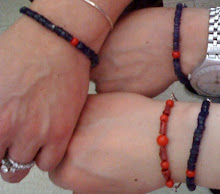With these basic techniques you can make any layered design.
I chose a simple 4 petal design. I used 18ga sterling silver sheet, 20ga copper sheet and copper wire 1/16"thick (I don't know what gauge it is).
First, draw a design on your silver sheet then drill a hole somewhere in the design that looks good to insert the saw blade. Pierce out your design. Saw any extra silver away.

Clean up the surface of your pierced design and file and sand the edges making sure to round the corners slightly (if there are corners).
Decide where you would like your rivets, and using a spring loaded punch or an awl with a hammer, make small indents where you are going to drill. This step is crucial because the drill bit will just skate across the metal if there is no guide for it.

Drill out all the holes in the top piece, and only one hole in the bottom piece.

Using wire that is the exact same size in diameter to the hole you drilled, cut the rivets to a length that will only allow a small amount to poke out each side of the rivet. If you have too much wire coming out the top and bottom, you will have a sloppy rivet that will most likely distort your design.

Clean up both ends of the wire rivet. I accomplish this by grasping the rivet in my flat nose pliers and rubbing the cut end on sandpaper.
Insert the wire rivet into the drilled holes of both top and bottom. Use the business end of your riveting hammer to gently make a bunch of cross hatched notches in the top (or a star pattern will work). Be careful, you don't want to mar the surface of your design, you only want to stretch the rivet out. Turn the piece over and do the same to the back of the rivet. You will still see a small bit of length on either side. Now turn the hammer over to the square flat side and hammer gently to flatten the metal, turning the piece over a couple of times to keep it even.

Now drill out the other hole. If your design had more than one rivet left to do, you could drill out the rest now. That first rivet is tight enough to hold it together. We waited until the first rivet was done so we could be assured of nicely lined up drilled holes. The rivet wire is exactly the same size as the hole, so any variance would make it impossible to insert the wire had it shifted.

Perfect hole for riveting.

Rivet the next holes the same way as the first.

Now finish sawing out your design then file and sand the edges. Sand the face to remove a bit more material to make it flush. I do this by turning the piece upside down on a piece of sandpaper 240 grit, then 320 grit, and so on until I reach the finish I desire, always sanding in the same direction.
Now you can either solder a bail onto the pendant, or since we are doing a cold connection, just drill a hole for a jumpring.

Hope you enjoyed.































